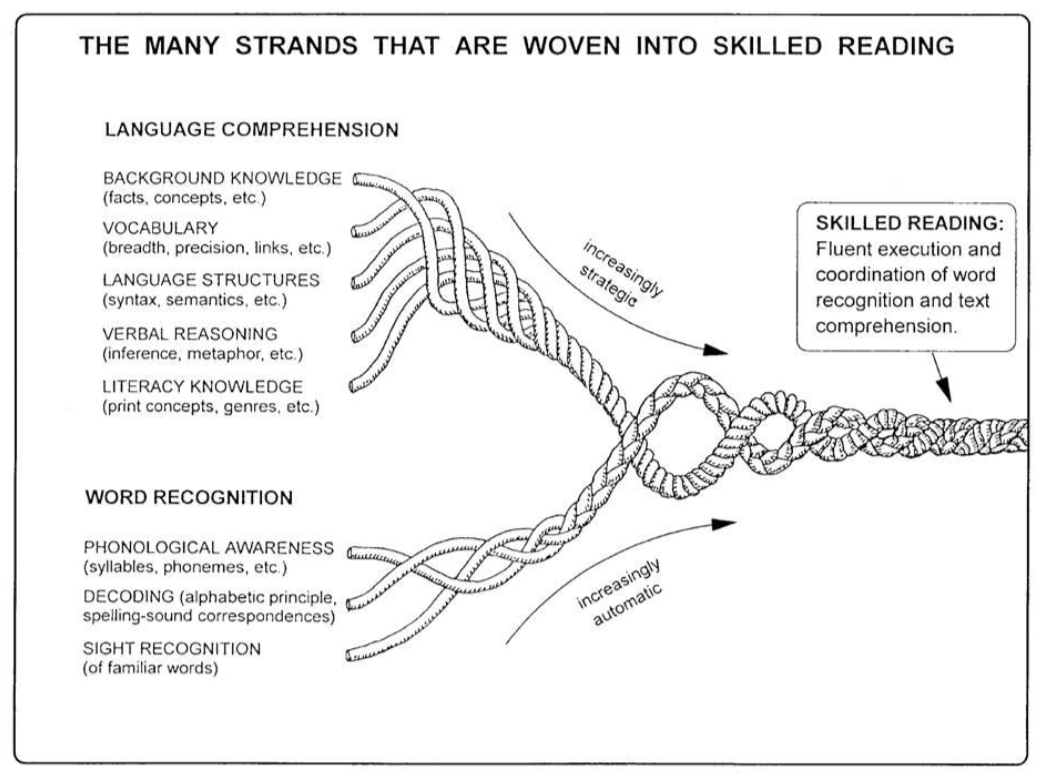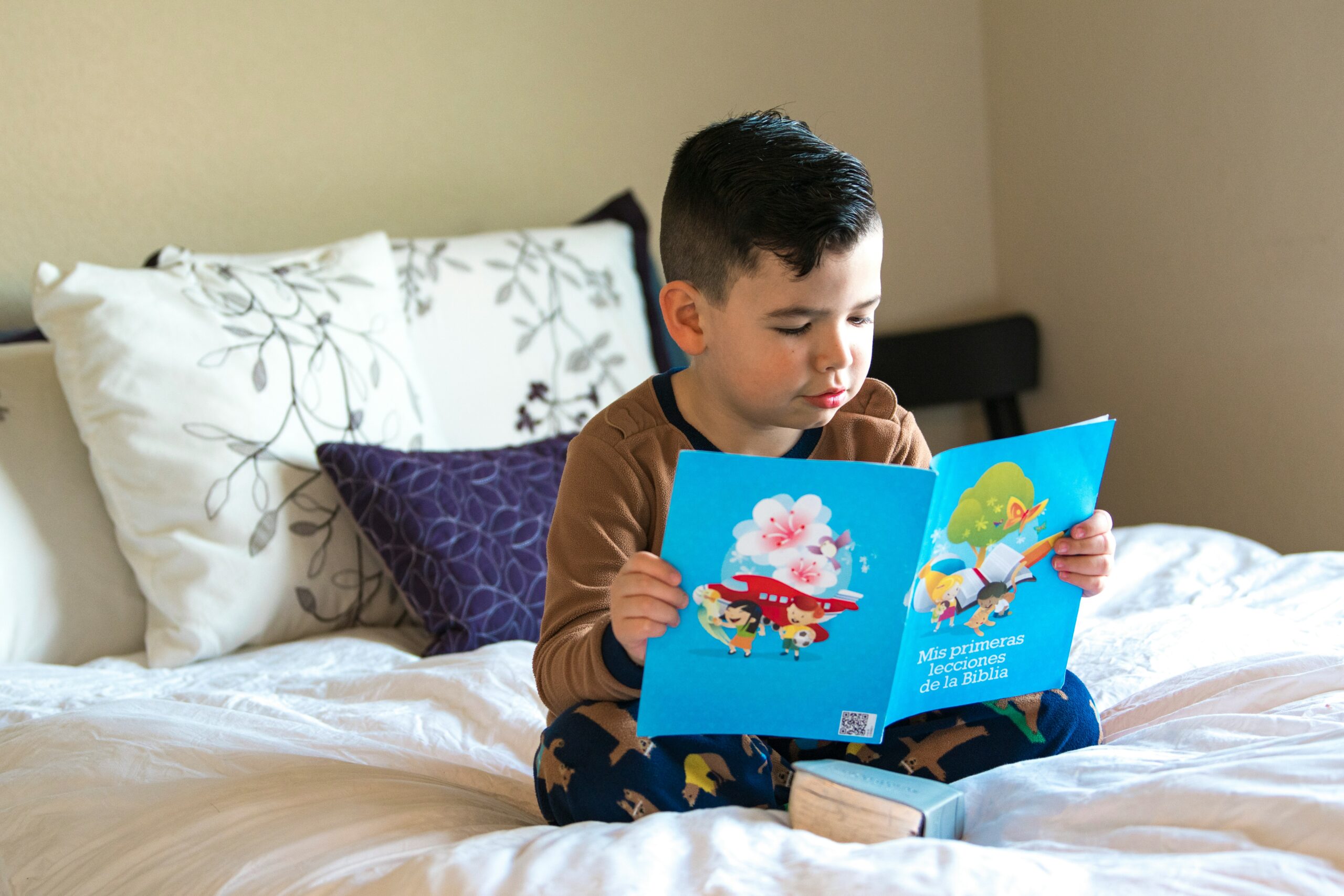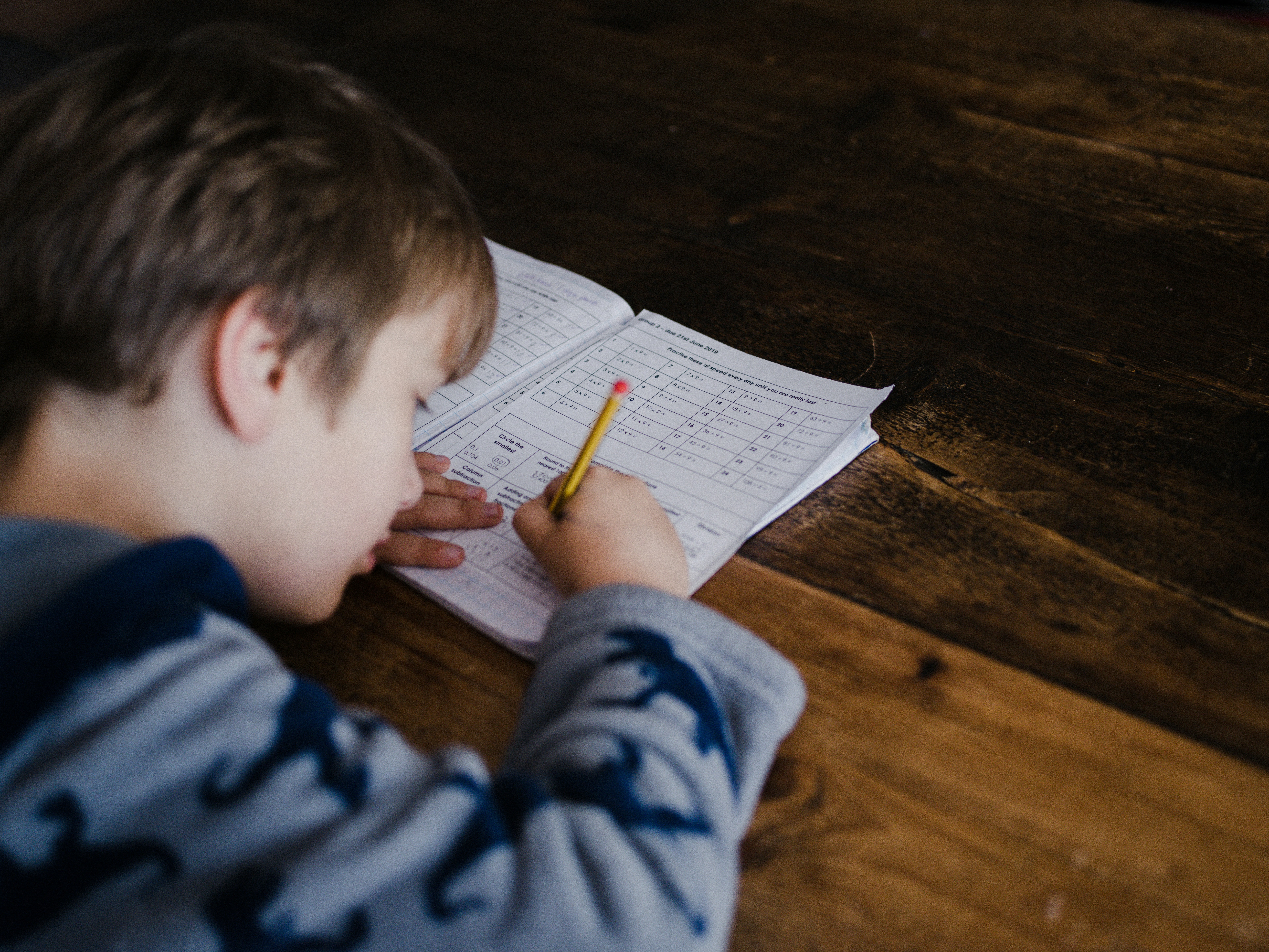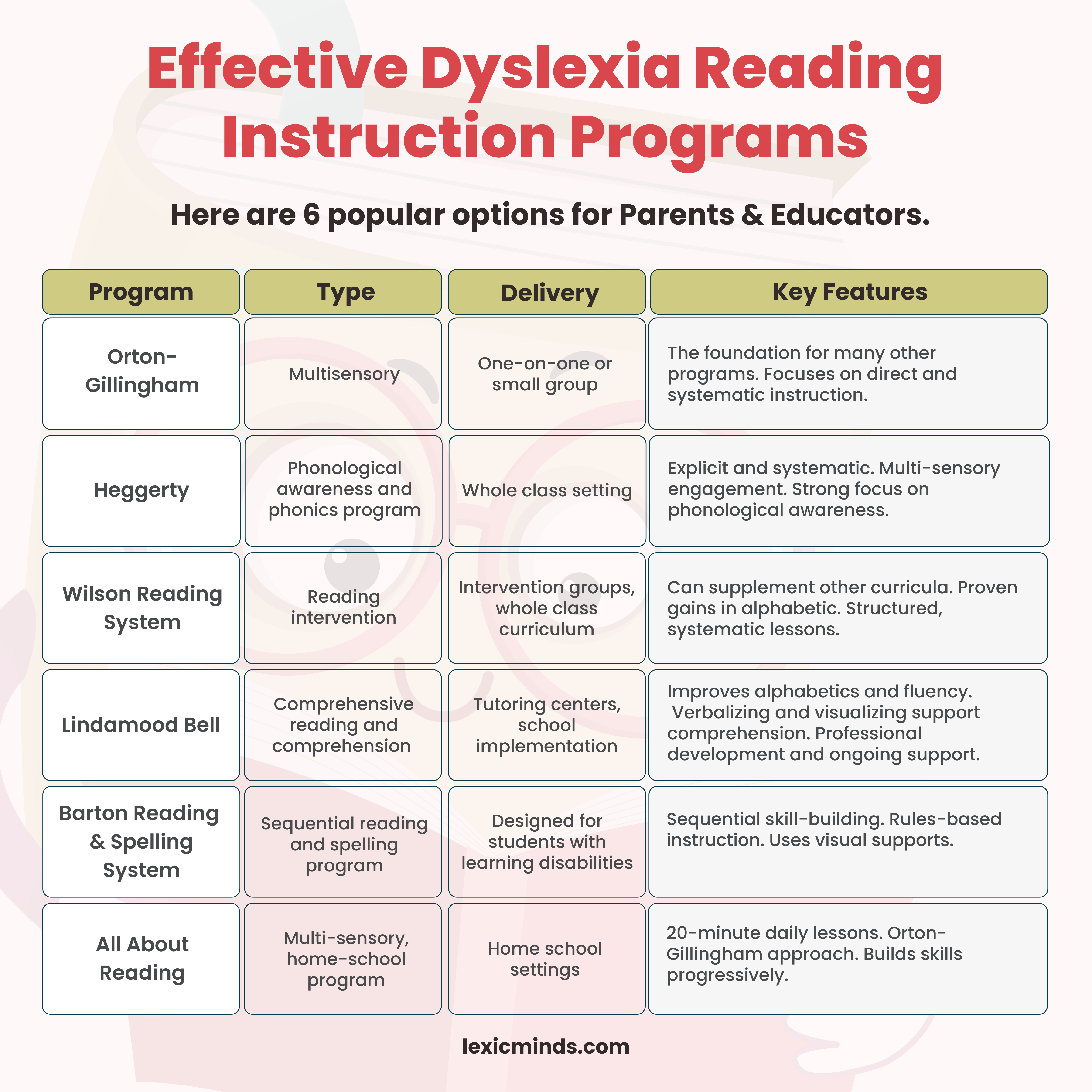Each child’s path to reading is different, and that is especially true for kids with Dyslexia. The one thing we do know about these unique children is that they will, at some point, need accomodations to learn to read. This is why parents and teachers need to inform themselves about Dyslexia reading instruction methods for kids. Their response makes all the difference in their reading development and how they see themselves as readers and students.
This entry prepared for you is a great starting point.
How do kids learn to read?
Learning to read is a complex process that happens over the years. As kids learn to read, they develop five core skills that, eventually, they use simultaneously to read.Â

In their early years, children develop phonological awareness or the ability to hear individual words and sounds in words.
Think: singing rhyming songs that involve playing with letters in words or rhyming.Â
As students enter school, they start to learn letter names and sounds (also called phonics). Children learn to associate letters and letter patterns with sounds and then blend those sounds to read words. For example, students learn that the letters “ea” together make a long E sound and can read the words “beach” and “heat.”Â
Once students have learned enough phonics patterns and sight words (sight words are words that we learn to read “by sight” like “the” and “good.” They may follow phonics rules but not always), they will start building fluency, or the ability to read at an age-appropriate rate, with expression and accuracy.Â
Along the way, students will build vocabulary, word knowledge, and reading comprehension. Students’ vocabulary helps them connect words they read with meaning, and comprehension helps students use their general language skills to understand sentences, paragraphs, and texts.Â
Do students with Dyslexia learn to read differently?Â
Young children with Dyslexia struggle with the foundations of language—they may be late in learning to talk or use vocabulary. They may demonstrate confusion when processing information, like directions (right/left, before/after), and difficulty with rhyming words or songs.Â
As they get into school, students with Dyslexia may have difficulty counting syllables in a word or identifying rhyming words. They may have trouble learning letter sounds or remembering names and letters when reading.
Students with Dyslexia may reverse letters or confuse letters like b and d or p and q, but this is not the only characteristic of Dyslexia.
As students move from reading individual words to sentences and paragraphs, their reading may be slow and labored, like they are struggling to get each word off the page. Finally, they may not understand what they read as they are spending all their energy to read each word and aren’t able to connect the words with language they already know.Â

How do students with Dyslexia learn to read?Â
Students with Dyslexia are not going to “pick up” reading. They cannot learn to read by watching a teacher, by being expected to notice patterns in words, or by working through activities where they are expected to build their own knowledge of reading. Instead, they need instruction that is:Â
- Explicit: skills are taught directly,
- Systematic: teaches skills in a definite, logical sequence,
- Structured: has procedures for introducing, reviewing, and practicing skills
- Multi-sensory: engages multiple senses, like visual, auditory, and kinesthetic channels, at the same time or in quick succession.Â

6 Dyslexia reading instruction methods for kids
There are various programs available that are proven to support students with Dyslexia. Each program will have a different impact on each learner, so it’s important to find the program that works best for your child.
Each of the six Dyslexia reading instruction methods for kids in our list incorporates the foundational principles that a child with Dyslexia needs to learn to read.Â
Orton-GillinghamÂ
Orgon-Gillingham is the original multi-sensory approach to teaching reading, and many other programs use its principles as a foundation. It’s an approach, not a program or system, so teachers and tutors are trained in Orton-Gillingham and use it with students. OGA is typically delivered one-on-one but can be used in small group settings.Â
Heggerty
Heggerty is the original explicit, systematic program for phonological awareness that incorporates multi-sensory engagement. They also have a phonics program meant to be implemented in a whole class setting.Â
Wilson Reading SystemÂ
Wilson is a reading intervention designed to be delivered in schools and in intervention groups.
It does have a whole class curriculum, and Wilson Reading System lessons can be delivered in addition to that curriculum for students who need it, or teachers can use Wilson in addition to another curriculum. Wilson has been studied by researchers and produced gains in alphabetics.Â
Lindamood Bell
Lindamood Bell is best known for its programs (Lindamood Phoneme Sequencing or LiPS and Verbalizing and Visualizing) that support early reading and comprehension. Their LiPS program has been shown to improve alphabetics and reading fluency. Lindamood Bell has tutoring centers that use their programs, or programs can be used in schools. The company provides professional development and ongoing support.Â
Barton Reading and Spelling SystemÂ
The Barton system was designed for students who struggle with reading due to Dyslexia or another learning disability. It teaches skills in sequential order, so as students learn skills, they use them over and over to gain confidence. Barton teaches students the rules of reading and why Cat starts with a C while Kitten with a K. Barton also uses visuals to support students’ learning.
All About ReadingÂ
All About Reading (and the companion All About Spelling) were developed by a mom whose son has Dyslexia. The 20-minute multi-sensory lessons use an Orton-Gillingham approach to teach one skill per day and provide practice that builds from skill to skill. The program is designed to be implemented in home school settings.Â
Need help from a tutor? Submit this form, and we’ll refer you to the right person.
What can I ask my dyslexic child’s school to provide?Â
If your child is not progressing in reading, it’s essential to know how most schools approach curriculum. Curriculum decisions are multi-year decisions, and often, schools commit to specific curricula for five years or more.
Shifting curriculums is difficult, though there has been a broader shift in education towards explicit, systematic phonics instruction in recent years, so you may find that their core curriculum is already explicit, systematic, and structured.Â
What if my child has an IEP?
If a child has an IEP, the school must provide the student with a Free Appropriate Public Education or FAPE. This means that student is provided with a free education that provides some educational benefit and prepares them for more schooling, career, and independent living. However, FAPE does not guarantee a parent the “best” education or a specific program.Â

How can I make sure my child gets the right reading instruction in their IEP?Â
Schools are often reluctant to include specific programs or interventions in a student’s IEP. This usually comes down to not wanting to mandate having to implement a specific program, buying the curriculum, and training teachers.
While you may not be able to have your child taught using a specific program, there are ways to advocate for the most appropriate reading instruction.Â
Read more about IEP and the 504 plan here, and how to find the best advocate for your kid here.
Focus on methodologies
When developing an IEP, a teaching methodology is one thing that could be “individualized.” A child with Dyslexia should be receiving reading and writing instruction that follows evidence-based methodologies. Rather than focus on one program, insist that the IEP identify that your child’s reading instruction be explicit, systematic, structured, and multisensory. Federal law supports including a methodology within an IEP if it supports the students’ learning.Â
Advocate for the bigger picture
Reading instruction that is explicit, systematic, and structured benefits all students. When curriculum decisions are being made:
Can your child’s school adopt a general curriculum that is good for students with Dyslexia, and will it include best practices for all learners?Â
➡️ Need an advocate’s support? Provide your details in this form, and we’ll connect you with the right advocate.
Seek out a school that already uses an evidence-based program in classrooms
Rather than try to get a specific program into your child’s IEP, see if you can find a school that already uses a curriculum. For example, Wilson or Heggerty support students with Dyslexia.Â
Key Takeaways
- Dyslexic students benefit from explicit, systematic, structured, and multi-sensory reading instruction methods.
- Programs like Orton-Gillingham, Heggerty, Wilson Reading System, Lindamood Bell, Barton Reading, and Spelling System, and All About Reading are effective for teaching students with Dyslexia.
- Parents have the right to advocate for explicit, systematic, and structured reading instruction methods in their child’s IEP.
- Choosing schools that already implement evidence-based reading programs can provide better support for dyslexic students.
Points of Action
- Investigate and familiarize yourself with the evidence-based reading programs mentioned here.
- Meet with your child’s school to discuss incorporating explicit, systematic, structured, and multi-sensory reading instruction methods into their IEP.
- Visit and assess local schools to find those that already use evidence-based reading programs and methodologies suitable for dyslexic students.
- Explore and implement assistive technology tools, like text-to-speech software, to support your child’s reading and comprehension at home. Visit our list of tech resources here.
Written by: Samantha Cleaver
Samantha Cleaver, PhD, has more than 15 years of expertise in reading disabilities, including Dyslexia. She has taught students with Dyslexia in elementary and middle school and has worked as a school-level director of special education.Â
Disclaimer: This is not medical advice. Please consult with a licensed professional when in doubt. Lexicminds is not liable for actions taken from this page.








